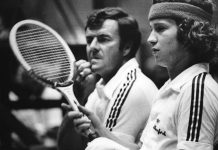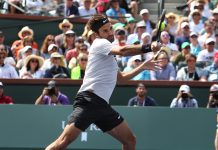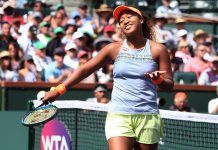It’s not time to throw out the old just yet, but it is time to start throwing a few glances toward the new.
That, in a nutshell, captured the season of SoCal’s touring pros. The multi-talented veteran Serena Williams, who lives in Beverly Hills, won her ninth Slam at the U.S. Open, while her older sister Venus, who also frequents L.A. and like Serena was born in Compton, won her fifth Wimbledon title. Three-time Slam champ Lindsay Davenport of the OC began the year in excellent form, winning two titles, but injuries got the best of the 32-year-old once again and she chose not to compete past the U.S. Open. Then, in December, she announced she was pregnant with her second child and all but retired again.
But youth was heard from, too. Thousand Oaks’ Sam Querrey, 21, won his first career title in Las Vegas and ended the year at No. 39, the fourth highest ranked U.S. player. He pushed Rafael Nadal at the U.S. Open and was more than competitive in his Davis Cup debut on clay in Spain, where he took a set off Nadal, the world’s most accomplished clay-courter and new No. 1. The big-hitting, soft-spoken Querrey appears to have more promise than any young American male.
A new face arose at the U.S. Open in the form of Rancho Santa Fe’s CoCo Vandeweghe, a pro who became the first American to win the U.S. Open girls’ title since ‘95 and looks all the part of an elite player-to-be.
The niece of former NBA standout Kiki Vandeweghe, the daughter of Olympian swimmer Tauna and granddaughter of former N.Y. Knick star Ernie, CoCo has rich athletic genes. She’s tall, powerful and can gun serves at 115 mph, and aced No. 1 Jelena Jankovic on the first point of their U.S. Open main-draw contest, which was won by the Serbian.
While her pro results have been erratic, she’s shown flashes of brilliance. Vandeweghe started playing fairly late and is still, in the words of her coach, Adam Peterson, “real raw.” But she has what a lot of other U.S. teens don’t have — size, weapons and an inner fire to be the best.
“She’s a tough girl, very competitive and a perfectionist,” said Peterson “She’s got a lot of what girls look for — real weapons. But because she started so late, she’s still trying to find her game and what will work for her when she’s not playing her best. When she’s on, she unstoppable, but when she’s off, she has trouble finding her way back into matches.”
Peterson has coached at the highest level, tutoring Davenport on and off and has an idea of what it take to make a great player. One thing he’s noticed is that even the most powerful competitors learn to play a little defense, mix it up and stay in points when their primary plan isn’t working. Vandeweghe can mix up her attack, but her game isn’t the mark of dependability.
“At this point she needs a ton of matches and to learn to let her shotmaking ability work itself out in matches by letting things come to her more,” he said. “I see her becoming an aggressive baseliner who can come to net a good amount, and hit a heavier rally ball, rather than trying to flatten it out like Lindsay or Sharapova. What she has to come to is an understanding of what will really work with her and that will take time.”
Jose Higueras, who used to coach Vandeweghe and is now the Director of Coaching for USTA Elite Player Development, added, “She definitely has something like you cannot teach and that’s power,” he said. That’s a great way to start. She’s becoming a little more consistent. She likes to be aggressive and if she can understand that aggressiveness and tame it to her advantage, then she’s got good potential.”
Just 17, Vandeweghe has a fair amount of time to prove herself, but ‘09 will be an important year. She’s proved that she can play at the highest junior level and throw some roundhouse punches at some of the lesser pros, but she ended ‘08 ranked in the 400s and by the time she turns 18 in December, she should at least crack the top 100. There are few notable players who have failed to do so, including Davenport (who had a year-end ranking of No. 6 when she was 18). Vandeweghe occasionally stays at Davenport’s home when she’s working with Peterson in the OC.
“In 2009, we’re going to find out how CoCo deals with the daily grind of tour life, the preparations, the work, the losses,” Peterson said. “But she can do some things that Lindsay can’t, even though you could say the same vice versa. She has all the tools to become a great player, it’s whether or not she learns to implement them.”
Kevin Kim turned 30 last summer and ended the year ranked No. 117. Like Andre Agassi preached toward the end of his career, tennis has become more of a journey and process for him than a means to an end. Results matter to some degree, but not that much. He feels that being consistent week in and week out is far more important, as is making subtle improvements rather than headline grabbing results.
That’s why the former UCLA All-American has survived 11 years on tour, and has made a healthy living. In ‘08, he only played three main ATP matches (all losses) but put his hard hat on in the Challengers and ended the year with more than $113,000 in earnings. He won Challengers at Aptos and Tulsa and reached the finals of Vancouver and Champaign.
He didn’t have a great start to the year, as he was struggling with which style he should employ and lost his way trying to be overly aggressive. “I was trying a different scheme to try to push a head, be a little more aggressive on my second serve, maybe serve and volley more,” said Kim, who added that he didn’t prioritize his footwork enough. “I’m always looking to improve, but I got out of my rhythm a little bit and that played on my mental game.”
But the Newport Beach resident regrouped and went back to his base, rediscovering what got him to the pros in the first place. Having a solid foundation and sticking with it is of the utmost importance — that and having confidence when the huge moments arrive. “The top guys don’t hit the ball any harder, but they find a consistently high level on the big points and that makes a big difference,” he said. “In order to be successful, you have to find the same remedy, not win a Challenger one week and then lose in the first round in the next six.”
Experience is on Kim’s side now as he attempts to push his ranking back into the top 100, where he will be guaranteed an entry into the Grand Slams. He has learned to deal with wins and losses much the same.
“I remember a few years ago losing to Jan Henrych 6-0, 6-0 in Wimbledon qualifying and when I came off court I didn’t feel that bad. I hit the ball pretty well and he just played great. The next week, I won a Challenger. I’ve never put heavy weight on wins and losses. The only way to get better is to learn from your losses, and as long as I play to the best of my abilities, I’m satisfied.”
Kim has not yet set a retirement date and says he won’t know when it’s time to put his rackets away until he loses motivation. He’s not willing to give up on his dreams, either. When he retires, he’s planning on returning to UCLA to finish his education, as he promised his parents when he turned pro after his freshman year.
“If I said I was satisfied with my tennis career, than I wouldn’t yearn for more,” he said. “I’m a competitive guy and expect a lot out of myself. But at the end of the day, I’ve met some great people and learned a lot during my career and I won’t retire bitter, regardless of what happens.”
There was little to celebrate beyond the aforementioned SoCal players. On the men’s’ side, Lester Cook finished the year ranked No. 354 and Michael McClune sat at No. 447. On the women’s side, Vania King, who ended ‘06 ranked No. 50, slumped to No. 127, Angela Haynes stood at No. 139 and, even after a decent fall, the once promising Alexa Glatch finished at No. 153.
On the Open level, Robert Yim and Alison Ramos took the Adoption Guild titles, and Yim also won the Top Gun. Former Cal standout and NCAA singles titlist Suzi Babos took the women’s singles at Top Gun. Cecil Mamiit and Pamela Montez won the Ojai titles.


















